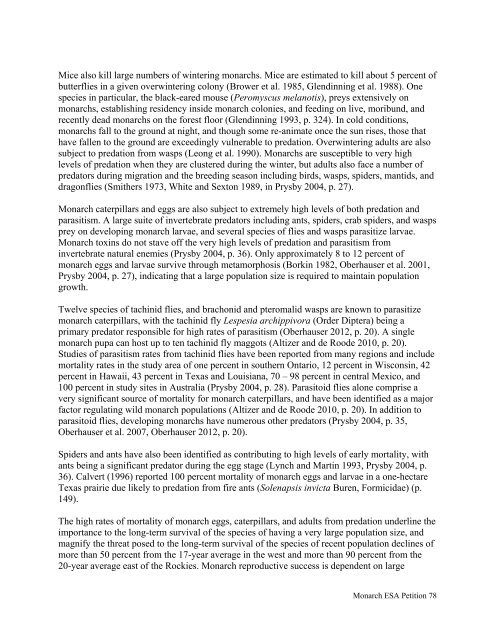monarch-esa-petition-final_61585
monarch-esa-petition-final_61585
monarch-esa-petition-final_61585
Create successful ePaper yourself
Turn your PDF publications into a flip-book with our unique Google optimized e-Paper software.
Mice also kill large numbers of wintering <strong>monarch</strong>s. Mice are estimated to kill about 5 percent of<br />
butterflies in a given overwintering colony (Brower et al. 1985, Glendinning et al. 1988). One<br />
species in particular, the black-eared mouse (Peromyscus melanotis), preys extensively on<br />
<strong>monarch</strong>s, establishing residency inside <strong>monarch</strong> colonies, and feeding on live, moribund, and<br />
recently dead <strong>monarch</strong>s on the forest floor (Glendinning 1993, p. 324). In cold conditions,<br />
<strong>monarch</strong>s fall to the ground at night, and though some re-animate once the sun rises, those that<br />
have fallen to the ground are exceedingly vulnerable to predation. Overwintering adults are also<br />
subject to predation from wasps (Leong et al. 1990). Monarchs are susceptible to very high<br />
levels of predation when they are clustered during the winter, but adults also face a number of<br />
predators during migration and the breeding season including birds, wasps, spiders, mantids, and<br />
dragonflies (Smithers 1973, White and Sexton 1989, in Prysby 2004, p. 27).<br />
Monarch caterpillars and eggs are also subject to extremely high levels of both predation and<br />
parasitism. A large suite of invertebrate predators including ants, spiders, crab spiders, and wasps<br />
prey on developing <strong>monarch</strong> larvae, and several species of flies and wasps parasitize larvae.<br />
Monarch toxins do not stave off the very high levels of predation and parasitism from<br />
invertebrate natural enemies (Prysby 2004, p. 36). Only approximately 8 to 12 percent of<br />
<strong>monarch</strong> eggs and larvae survive through metamorphosis (Borkin 1982, Oberhauser et al. 2001,<br />
Prysby 2004, p. 27), indicating that a large population size is required to maintain population<br />
growth.<br />
Twelve species of tachinid flies, and brachonid and pteromalid wasps are known to parasitize<br />
<strong>monarch</strong> caterpillars, with the tachinid fly Lespesia archippivora (Order Diptera) being a<br />
primary predator responsible for high rates of parasitism (Oberhauser 2012, p. 20). A single<br />
<strong>monarch</strong> pupa can host up to ten tachinid fly maggots (Altizer and de Roode 2010, p. 20).<br />
Studies of parasitism rates from tachinid flies have been reported from many regions and include<br />
mortality rates in the study area of one percent in southern Ontario, 12 percent in Wisconsin, 42<br />
percent in Hawaii, 43 percent in Texas and Louisiana, 70 – 98 percent in central Mexico, and<br />
100 percent in study sites in Australia (Prysby 2004, p. 28). Parasitoid flies alone comprise a<br />
very significant source of mortality for <strong>monarch</strong> caterpillars, and have been identified as a major<br />
factor regulating wild <strong>monarch</strong> populations (Altizer and de Roode 2010, p. 20). In addition to<br />
parasitoid flies, developing <strong>monarch</strong>s have numerous other predators (Prysby 2004, p. 35,<br />
Oberhauser et al. 2007, Oberhauser 2012, p. 20).<br />
Spiders and ants have also been identified as contributing to high levels of early mortality, with<br />
ants being a significant predator during the egg stage (Lynch and Martin 1993, Prysby 2004, p.<br />
36). Calvert (1996) reported 100 percent mortality of <strong>monarch</strong> eggs and larvae in a one-hectare<br />
Texas prairie due likely to predation from fire ants (Solenapsis invicta Buren, Formicidae) (p.<br />
149).<br />
The high rates of mortality of <strong>monarch</strong> eggs, caterpillars, and adults from predation underline the<br />
importance to the long-term survival of the species of having a very large population size, and<br />
magnify the threat posed to the long-term survival of the species of recent population declines of<br />
more than 50 percent from the 17-year average in the west and more than 90 percent from the<br />
20-year average east of the Rockies. Monarch reproductive success is dependent on large<br />
Monarch ESA Petition 78




